Related Research Articles

The cosmic microwave background, in Big Bang cosmology, is electromagnetic radiation which is a remnant from an early stage of the universe, also known as "relic radiation". The CMB is faint cosmic background radiation filling all space. It is an important source of data on the early universe because it is the oldest electromagnetic radiation in the universe, dating to the epoch of recombination. With a traditional optical telescope, the space between stars and galaxies is completely dark. However, a sufficiently sensitive radio telescope shows a faint background noise, or glow, almost isotropic, that is not associated with any star, galaxy, or other object. This glow is strongest in the microwave region of the radio spectrum. The accidental discovery of the CMB in 1965 by American radio astronomers Arno Penzias and Robert Wilson was the culmination of work initiated in the 1940s, and earned the discoverers the 1978 Nobel Prize in Physics.

The Wilkinson Microwave Anisotropy Probe (WMAP), originally known as the Microwave Anisotropy Probe (MAP), is an inactive uncrewed spacecraft operating from 2001 to 2010 which measured temperature differences across the sky in the cosmic microwave background (CMB) – the radiant heat remaining from the Big Bang. Headed by Professor Charles L. Bennett of Johns Hopkins University, the mission was developed in a joint partnership between the NASA Goddard Space Flight Center and Princeton University. The WMAP spacecraft was launched on June 30, 2001 from Florida. The WMAP mission succeeded the COBE space mission and was the second medium-class (MIDEX) spacecraft in the NASA Explorers program. In 2003, MAP was renamed WMAP in honor of cosmologist David Todd Wilkinson (1935–2002), who had been a member of the mission's science team. After nine years of operations, WMAP was switched off in 2010, following the launch of the more advanced Planck spacecraft by European Space Agency in 2009.
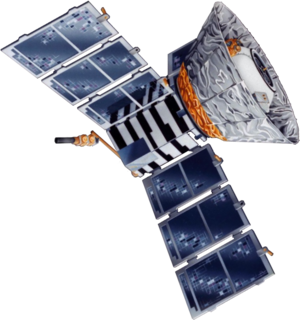
The Cosmic Background Explorer, also referred to as Explorer 66, was a satellite dedicated to cosmology, which operated from 1989 to 1993. Its goals were to investigate the cosmic microwave background radiation (CMB) of the universe and provide measurements that would help shape our understanding of the cosmos.
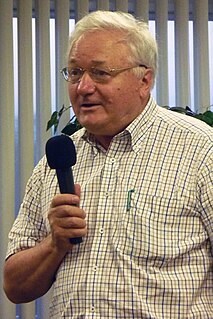
Rashid Alievich Sunyaev is a Soviet and Russian astrophysicist of Tatar descent. He got his MS degree from the Moscow Institute of Physics and Technology (MIPT) in 1966. He became a professor at MIPT in 1974. Sunyaev was the head of the High Energy Astrophysics Department of the Russian Academy of Sciences, and has been chief scientist of the Academy's Space Research Institute since 1992. He has also been a director of the Max Planck Institute for Astrophysics in Garching, Germany since 1996, and Maureen and John Hendricks Distinguished Visiting Professor in the School of Natural Sciences at the Institute for Advanced Study in Princeton since 2010.

In physical cosmology, the age of the universe is the time elapsed since the Big Bang. Today, astronomers have derived two different measurements of the age of the universe: a measurement based on direct observations of an early state of the universe, which indicate an age of 13.787±0.020 billion years as interpreted with the Lambda-CDM concordance model as of 2018; and a measurement based on the observations of the local, modern universe, which suggest a younger age. The uncertainty of the first kind of measurement has been narrowed down to 20 million years, based on a number of studies which all gave extremely similar figures for the age. These include studies of the microwave background radiation by the Planck spacecraft, the Wilkinson Microwave Anisotropy Probe and other space probes. Measurements of the cosmic background radiation give the cooling time of the universe since the Big Bang, and measurements of the expansion rate of the universe can be used to calculate its approximate age by extrapolating backwards in time. The range of the estimate is also within the range of the estimate for the oldest observed star in the universe.

Planck was a space observatory operated by the European Space Agency (ESA) from 2009 to 2013, which mapped the anisotropies of the cosmic microwave background (CMB) at microwave and infrared frequencies, with high sensitivity and small angular resolution. The mission substantially improved upon observations made by the NASA Wilkinson Microwave Anisotropy Probe (WMAP). Planck provided a major source of information relevant to several cosmological and astrophysical issues, such as testing theories of the early Universe and the origin of cosmic structure. Since the end of its mission, Planck has defined the most precise measurements of several key cosmological parameters, including the average density of ordinary matter and dark matter in the Universe and the age of the universe.

The Atacama Cosmology Telescope (ACT) is a six-meter diameter telescope located on Cerro Toco in the Atacama Desert in the north of Chile, near the Llano de Chajnantor Observatory. ACT makes high-sensitivity, high-resolution, microwave-wavelength surveys of the sky in order to study the cosmic microwave background radiation (CMB), the relic radiation left by the Big Bang process. At an altitude of 5,190 metres (17,030 ft), it is one of the highest permanent, ground-based telescopes in the world.
David Nathaniel Spergel, is an American theoretical astrophysicist. He is President of the Simons Foundation and the Charles A. Young Professor of Astronomy on the Class of 1897 Foundation, Emeritus, at Princeton University. He founded the Center for Computational Astrophysics and served as its first director. Spergel is known for his work on the WMAP mission. Spergel is a MacArthur Fellow. He was a member of the NASA Advisory Council and chair of the Space Studies Board. He was once the W.M. Keck distinguished visiting professor at the Institute for Advanced Study in Princeton, New Jersey. He was part of the team that originated the WMAP mission and designed the spacecraft, and has worked on deciphering the data that it beams back from space. Spergel is playing a leading role in developing the Nancy Grace Roman Space Telescope, a multibillion-dollar space mission planned for launch in the mid-2020s. He shared the 2010 Shaw Prize in astronomy with Charles L. Bennett and Lyman Alexander Page, Jr. for their work on WMAP. He shared the 2015 Dannie Heineman Prize with Marc Kamionkowski "for their outstanding contributions to the investigation of the fluctuations of the cosmic microwave background that have led to major breakthroughs in our understanding of the universe".
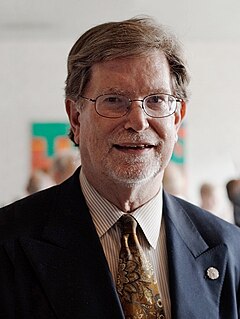
George Fitzgerald Smoot III is an American astrophysicist, cosmologist, Nobel laureate, and one of two contestants to win the US$1 million prize on Are You Smarter than a 5th Grader?. He won the Nobel Prize in Physics in 2006 for his work on the Cosmic Background Explorer with John C. Mather that led to the "discovery of the black body form and anisotropy of the cosmic microwave background radiation".

Charles L. Bennett is an American observational astrophysicist. He is a Bloomberg Distinguished Professor, the Alumni Centennial Professor of Physics and Astronomy and a Gilman Scholar at Johns Hopkins University. He is the Principal Investigator of NASA's highly successful Wilkinson Microwave Anisotropy Probe (WMAP).
Edward L. (Ned) Wright is an American astrophysicist and cosmologist, well known for his achievements in the COBE, WISE, and WMAP projects and as a strong Big Bang proponent in web tutorials on cosmology and theory of relativity.

In astrophysics, dark flow is a theoretical non-random component of the peculiar velocity of galaxy clusters. The actual measured velocity is the sum of the velocity predicted by Hubble's Law plus a possible small and unexplained velocity flowing in a common direction.
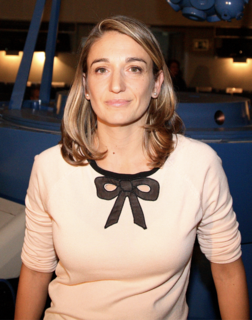
Licia Verde is an Italian cosmologist and theoretical physicist and currently ICREA Professor of Physics and Astronomy at the University of Barcelona. Her research interests include large-scale structure, dark energy, inflation and the cosmic microwave background.
The "Axis of Evil" is a name given to an anomaly in astronomical observations of the cosmic microwave background (CMB). The anomaly appears to give the plane of the Solar System and hence the location of Earth a greater significance than might be expected by chance – a result which has been claimed to be evidence of a departure from the Copernican principle.
Michele Limon is an Italian research scientist at the University of Pennsylvania. Limon studied physics at the Università degli Studi di Milano in Milan, Italy and completed his post-doctoral work at the University of California, Berkeley. He has been conducting research for more than 30 years and has experience in the design of ground, balloon and space-based instrumentation. His academic specialties include Astrophysics, Cosmology, Instrumentation Development, and Cryogenics.
Rachel Bean is a cosmologist and theoretical astrophysicist. She is a professor of astronomy at Cornell University.
Olivier Doré is a cosmologist, who is currently working as research scientist in Jet Propulsion Laboratory and visiting associate faculty at the California Institute of Technology.

Hiranya V. Peiris is a British astrophysicist at University College London, best known for her work on the cosmic microwave background radiation. She was one of 27 scientists who received the Breakthrough Prize in Fundamental Physics in 2018 for their "detailed maps of the early universe."
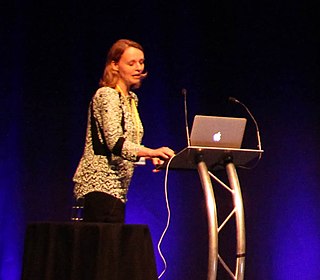
Joanna Dunkley is a British astrophysicist and Professor of Physics at Princeton University. She works on the origin of the Universe and the Cosmic microwave background (CMB) using the Atacama Cosmology Telescope, the Simons Observatory and the Large Synoptic Survey Telescope (LSST).
Norman C. Jarosik is a US astrophysicist. He has worked on the Wilkinson Microwave Anisotropy Probe (WMAP) whose observations of Cosmic Microwave Background Radiation (CMBR) have provided significant insights into cosmology.
References
- ↑ "Gary Hinshaw". UBC Physics & Astronomy. 30 November 2017. Retrieved 19 September 2018.
- 1 2 "Bio - Gary F Hinshaw". Sciences and Exploration Directorate. Archived from the original on 26 January 2019. Retrieved 19 September 2018.
- ↑ "At the Breakthrough Prizes, Silicon Valley Puts Scientists in the Spotlight". WIRED. 4 December 2017. Retrieved 19 September 2018.